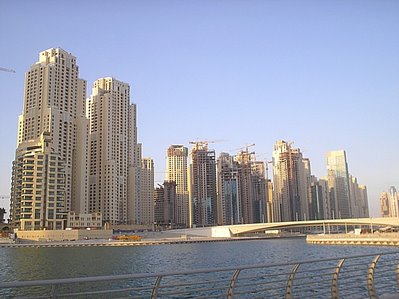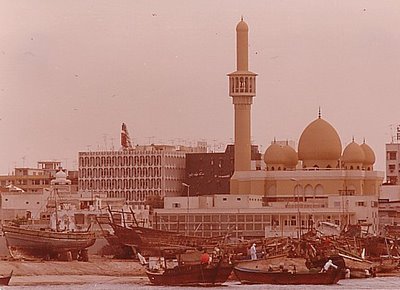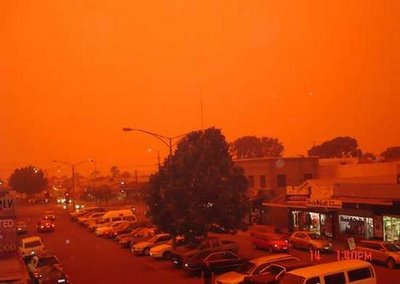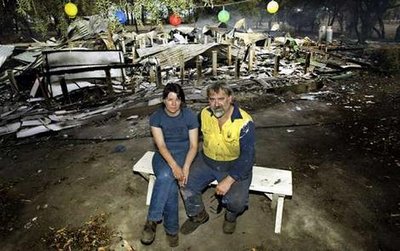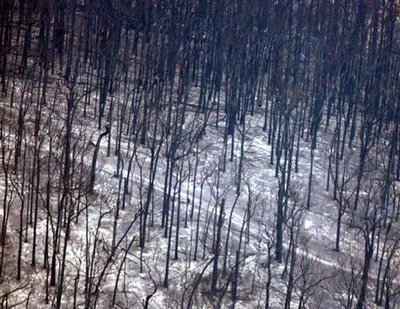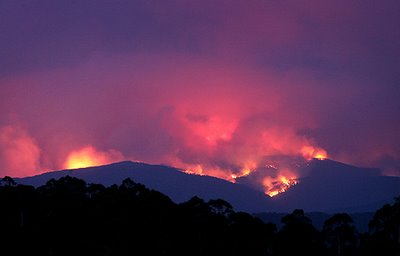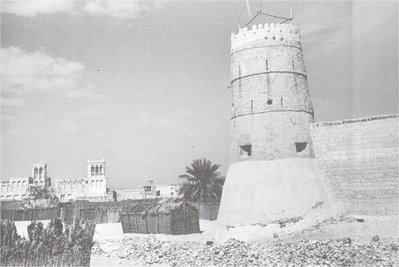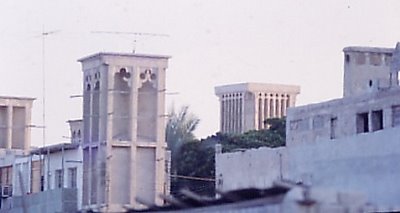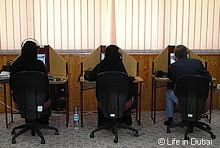 Photo: Sydney Morning Herald
Photo: Sydney Morning Herald
Victoria, Australia's second most populous state, is ablaze and you can't begin to imagine the size or ferocity of these fires.
Let me try to explain what they're facing.
Try to imagine a firefront 25 kilometres long, flames 100 feet high and travelling at 20 kph.That was just one of the 100 bushfires we had blazing all around Sydney during Christmas 2001. The worst day was the first, Christmas Day, when several townships were hit. 150 houses were destroyed.
People lost not only their house, furniture, clothing, their jewellery but their memories...wedding certificates, birth certificates, photos of their children growing up. Some had pets in the house...
They lost a lifetime, left with literally the clothes they were wearing. On Christmas Day.
Now in 2006 we're in one of the worst droughts in history, dams at historic low levels. Earlier in the year New South Wales and South Australia were hit by bushfires, way before the fire season usually begins.
Right now Victoria is under attack. So far more than a quarter million hectares have burnt with the fires out of control. None are contained and temperatures have topped 42C. That’s Melbourne’s hottest December day for over 50 years. What’s worse is hot, swirling winds of over 50kph.
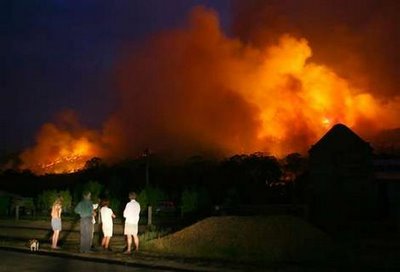 Photo: Craig Abraham. The Age
Photo: Craig Abraham. The AgeThree thousand firefighters are battling the blazes. Volunteer firefighters have gone in from other states and from New Zealand to help and the army is on standby.
Twelve fires sweeping down from the alpine region to Gippsland yesterday are expected to merge into two or three super fires today, fire behaviour experts have warned. If fires join up a firefront 100 kilometres wide is being predicted.
Think about that.
A fire more than 100 kilometres wide.
Australian bushfires are so big they're impossible to put out. They are so vast and so intense that many create their own weather conditions, the huge updraught creating unpredictable winds. The best the firefighters can do is to try to contain them by using natural firebreaks such as rivers and roads, carving more breaks around the fires, backburning ahead of the fires to deny them fuel. They try to let them burn themselves out within the containment lines - and pray for rain.
Water is scarce. Aircraft, helicopters and fire trucks are used unless, as happened yesterday they're grounded because the smoke has killed visibility. Thousands of firefighters - most of them our unbelievably brave bush fire brigades volunteers - do their best to defend lives and property.
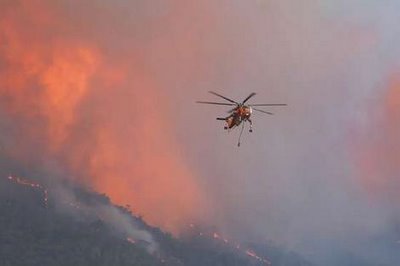 Photo: Chris Hocking. The Age
Photo: Chris Hocking. The AgeThe native wildlife has a terrible time, as do domestic animals. Motorists are warned to be aware of animals seeking shelter from the fires on the roads, the only fire-free strips available to them. People find wild native animals sheltering in their gardens. Farm animals are also caught in the fires - thousands of sheep, cattle and horses are killed. Farmers have to go out to shoot badly injured animals when the fire has passed. It's heartbreaking.
What's burning is our ubiquitous gum trees. Eucalypts. Full of highly flammable oil. They explode as the fire reaches them. That throws an ember storm up into the wind which carries it hundreds of metres. It jumps rivers, roads and containment lines that have been built and spot fires start ahead of the main blaze. People who've been near them talk about the terrible noise of the fires.
It's the ember storms that cause most property loss. Embers in the roof, in grass around the house and in minutes it's ablaze. We all know how to prepare the house in the face of oncoming fire, but in spite of heroic efforts many are lost. Homeowners do what they can but often an official evacuation order is given. If you've prepared properly the car is loaded with your most precious items, including important documents, photo albums and the pets. There's nothing more you can do.
So far in Victoria's current crisis two homes have been lost but no human lives. Animals will not have been as lucky.
But dozens of towns are under immediate threat as high winds fan the flames. The temperature is around 40C and humidity is low, disastrous weather for the firefighters. New fires are starting, caused by ember storms and lightning strikes, but also some inevitably by the murderous arsonists who crawl out from under their rocks every fire season.
This comment from today's Melbourne Age:
Despite the most frightening conditions since the Ash Wednesday fires that claimed 75 lives 23 years ago, Victoria has so far been spared the weekend of horror it had been warned to expect.
But Police chief commissioner Christine Nixon told journalists the bushfire threat remained extreme.
"We may lose lives," she said."We will lose more assets but we will have done the best we can to protect people and this whole environment."The Australian reports comment from two firefighters:
With firefighting experience totalling more than 80 years, John Mitchell and Bob Pearce have fought blazes up and down the east coast, seen lives lost and millions of hectares razed, but both say the fires raging through Victoria's alpine country are the worst they've seen.
"This is the biggest fire I've ever heard of in terms of area. When the wind comes up, this will be about as bad as it gets," Mr Mitchell said yesterday.
Mr Mitchell and Mr Pearce spent yesterday fighting to hold back a blaze in the valley just south of Whitfield, near Mansfield, hoping to stop it jumping the Whitfield-Mansfield road and threatening towns in Victoria's remote high country.
If the fire jumps the road, the forecast northerly winds mean the tiny town of Tolmie will be one of the first threatened.
"We need to stop the fire moving across the road because Tolmie looks ready to go," Mr Pearce said. "There's not much water up here, so we're relying on tankers, I don't reckon the helicopters will be much good, because they haven't got anywhere to pick up water from."The fires that came through Sydney suburbs in 1994 I remember well. It's an eerie experience. The sky is red or orange, there's a deathly quiet, you can smell smoke and burnt timber in the air. The lull before the storm. You prepare. And you wait.
This photo from Victoria gives me goose bumps because it sums up the atmosphere, the watching and waiting:
 Photo: Angela Wylie
Photo: Angela WylieThe State Emergency Service website gives an idea of the fires that year:
1993 - 1994, December - January, North Coast , Hunter & Sydney
Four dead - two civilians and two fire fighters
800 fires destroyed 800,000 hectares
225 homes and other buildings destroyed and a further 150 damaged
Evacuations - 27,250 people
Firefighters - estimated 20,000
In excess of 800 fires started between 27 December 1993 and 16 January 1994. Ultimately over 800,000 hectares were burnt. 204 significant bushfires were burning at the height of the crisis.
The most serious losses occurred in fires in the Sydney region, in particular at Jannali and West Como, where about half of the total homes lost in the State were destroyed. Two fire-fighters and two civilians died. One of the civilians was a woman who sheltered in a swimming pool at Jannali, but died of airway burns due to the intense heat of the air she was breathing.In 2003 Canberra, the federal capital, was badly hit by bushfires with four people killed and over 500 homes destroyed or badly damaged.
That's the sort of situation Victorians are facing at this very moment.
Between them and the fires are true heroes. The word has almost lost its meaning because it's used,
misused, so frequently. There
are true heroes, but I only acknowledge two groups - firefighters and lifeboat crew. People who volunteer and who run
towards the terror that the rest of us run away from.
 CFA volunteer Tony Tynan in fire-ravaged Rose River in north-eastern Victoria yesterday.Photo: Craig Abraham. The Age
CFA volunteer Tony Tynan in fire-ravaged Rose River in north-eastern Victoria yesterday.Photo: Craig Abraham. The Age
You can read the stories in
The Australian and
The Age
